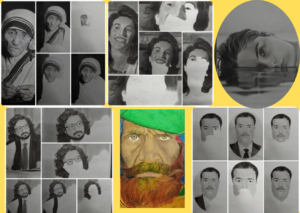


About the Author: Fazal ul Haq
I have a great passion for two things: photography and drawing. I had to give up photography due to financial constraints. I have been interested in drawing since my school days, and I always excelled in this subject.
My Achievements!
I have received nine awards in the fields of photography and art. I have been shortlisted many times as well.
- In 2012, I secured the 1st position in Photography at the Youth Festival.
- In 2014, I came in 2nd place in Poster Design at the American Consulate’s Earth Day competition.
- I also achieved 1st position in Photography at the Youth Peace Festival in Lahore in 2013.
- In 2015, at the Karachi Youth Festival, I received two awards – 3rd position in Photography and a Special Award in Painting.
- In 2014, at PAF KIET University, I secured the 3rd position in Sketching, and in 2016, I again came in 3rd place in Painting.
- In 2023, I achieved 1st position in Sketching, thanks to Snowball Education.
These accomplishments reflect my dedication and passion for the arts, and I hope to continue pursuing my interests in photography and drawing in the future.
Let me share some useful knowledge that I have learned in many years. I will also share some tips that you should know if you want to learn professional sketching skills.
“U make, what u see…”
Remember choose a good quality picture. If the quality is good, you can see even the finest details because sketching is all about detailing.
“Explore your tools…”
As a beginner, you should try full spectrum of graphite grades. Know your tools, how you can create different values and marks with soft and hard graphite pencils.
“Surface can affect the application…”
Heavier textures is visible through your drawing. While smoother textures will produce smooth unbroken effect and gradations of value. Experiment with both textures to explore the possibilities. I recommend use medium tooth drawing paper and charcoal paper. Remember you can use graphite on charcoal paper.
“Use Charcoal…”
Charcoal brings more variety to your black and white drawing. Charcoal is available in both stick and pencil form. Sticks of charcoal can be “vine” or “compressed”. Vine soft charcoal produces lighter marks. While compressed charcoal create darker marks. I like Charcoal pencils because they can be sharpened like graphite pencils, and are great for details.
“Highlights bring life…”
Use kneaded and electric eraser for fine details. Identify the primary light source in your sketch. This will determine where highlights and shadows should be.
Observation: Observe your subject closely. Pay attention to areas that catch more light, as these are the places where highlights will be most prominent.
Create Contrast: To highlight, you need to create contrast with the surrounding areas. Use a lighter pencil or shading technique to mark the highlighted areas. Press gently for lighter highlights and harder for more prominent ones.
Feathering: Use a gentle, feathery stroke to create a soft transition from the highlighted area to the rest of the drawing. Avoid hard lines.
“Explore drawing pens and inks and let your options open…”
Always keep your options open if you can achieve more effects with other mediums. Be more careful with your marks as you can’t erase them.
“Shading add style…”
A beginner try to create outlines even if it’s not required. This is the mistake every beginner make. Use of negative space is important. Instead of shading the subject itself, shade the space around it to define its shape and form. Blending stumps are important for the smudge effect. People use their fingers to blend but it sometimes create dirt effect. Try different shading methods like hatching, stippling, scumbling etc
“Some areas has to be blur to create pop effect for other areas…”
We have to reduce the sharpness of some areas and edges. So decide where to use a normal pencil and where to use a sharp pencil and where to blur the drawing.
“Take your time…”
When you’re creating a sketch, take breaks from time to time. This will help you identify your mistakes in the sketch and refresh your mind, making it easier to continue.
“Ready to learn…”…
Stay passionate! And welcome new learning opportunities..!
The dedication to continuous improvement and the willingness to explore and learn are traits that can help you evolve as an artist over time. Keep exploring, experimenting, and challenging yourself in your artistic journey. Every piece you create is a step toward honing your skills and expressing your unique perspective.
Follow me on social media and explore more of my work!
